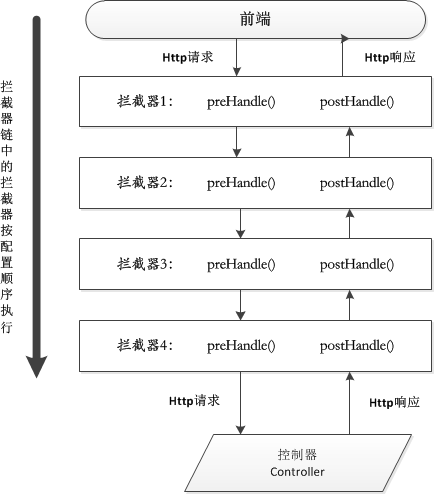参考:感谢各位辛苦整理!
https://blog.csdn.net/qq_35246620/article/details/68487904
https://www.cnblogs.com/lcngu/p/7096597.html
https://www.cnblogs.com/daimajun/p/7172208.html
https://blog.csdn.net/wscrf/article/details/72770853
想对Spring MVC拦截器的用法做一个详细的整理,从网上搜了一下,发现有人整理的很好(https://www.cnblogs.com/lcngu/p/7096597.html),特记录如下
1. 拦截器的实现方式
在 Spring 框架之中,咱们要想实现拦截器的功能,主要通过两种途径,第一种是实现HandlerInterceptor接口,第二种是实现WebRequestInterceptor接口。
其中第一种方法较为常用,在HandlerInterceptor接口中,定义了 3 个方法,分别为preHandle()、postHandle()和afterCompletion(),咱们就是通过复写这 3 个方法来对用户的请求进行拦截处理的。因此,咱们可以通过直接实现HandlerInterceptor接口来实现拦截器的功能。
2. 配置拦截器
在spring MVC项目的配置文件dispatcher-servlet.xml中,添加拦截器配置,如下所示
<!-- 配置用于session验证的拦截器 --> <!-- 如果有多个拦截器满足拦截处理的要求,则依据配置的先后顺序来执行 --> <mvc:interceptors> <mvc:interceptor> <!-- 拦截所有的请求,这个必须写在前面,也就是写在【不拦截】的上面 --> <mvc:mapping path="/**" /> <!-- 但是排除下面这些,也就是不拦截请求 --> <mvc:exclude-mapping path="/login.html" /> <mvc:exclude-mapping path="/account/login.do" /> <mvc:exclude-mapping path="/account/regist.do" /> <!-- 拦截器java代码路径 --> <bean class="com.msym.cloudnote.interceptors.LogsInterceptor" /> </mvc:interceptor> </mvc:interceptors>
【说明】:
1)mvc:mapping 拦截器路径配置,其中/** 的意思是所有文件夹及里面的子文件夹,(/*是所有文件夹,不含子文件夹,/是web项目的根目录,三者的作用需要深入研究)
2)mvc:exclude-mapping 拦截器不需要拦截的路径
3)mvc:mapping(拦截)一定要写于mvc:exclude-mapping之前
3. 拦截器代码
public class LogsInterceptor extends HandlerInterceptorAdapter { private static final Logger logger = LoggerFactory.getLogger(LogsInterceptor.class); private NamedThreadLocal<String> logContext = new NamedThreadLocal<String>("log-id"); @Autowired private TLogDao logDao; /** * preHandle方法是进行处理器拦截用的,顾名思义,该方法将在Controller处理之前进行调用, * SpringMVC中的Interceptor拦截器是链式的,可以同时存在多个Interceptor, * 然后SpringMVC会根据声明的前后顺序一个接一个的执行, * 而且所有的Interceptor中的preHandle方法都会在Controller方法调用之前调用。 * SpringMVC的这种Interceptor链式结构也是可以进行中断的, * 这种中断方式是令preHandle的返回值为false,当preHandle的返回值为false的时候整个请求就结束了。 */ @Override public boolean preHandle(HttpServletRequest request, HttpServletResponse response, Object handler) throws Exception { String host = request.getRemoteHost(); String url = request.getRequestURI(); TLogEntity entity = new TLogEntity(); entity.setCreateTime(new Timestamp(System.currentTimeMillis())); entity.setCreateUser("admin"); entity.setIpAddress(host); entity.setLogUrl(url); entity.setIsSuccess("N"); logDao.save(entity); logContext.set(entity.getLogId()); logger.debug("IP为---->>> " + host + " <<<-----访问了系统"); return true; } /** * 这个方法只会在当前这个Interceptor的preHandle方法返回值为true的时候才会执行。 * postHandle是进行处理器拦截用的,它的执行时间是在处理器进行处理之 后, 也就是在Controller的方法调用之后执行, * 但是它会在DispatcherServlet进行视图的渲染之前执行,也就是说在这个方法中你可以对ModelAndView进行操作。 * 这个方法的链式结构跟正常访问的方向是相反的,也就是说先声明的Interceptor拦截器该方法反而会后调用, * 这跟Struts2里面的拦截器的执行过程有点像, * 只是Struts2里面的intercept方法中要手动的调用ActionInvocation的invoke方法, * Struts2中调用ActionInvocation的invoke方法就是调用下一个Interceptor或者是调用action, * 然后要在Interceptor之前调用的内容都写在调用invoke之前,要在Interceptor之后调用的内容都写在调用invoke方法之后。 */ @Override public void postHandle(HttpServletRequest request, HttpServletResponse response, Object handler, ModelAndView modelAndView) throws Exception { } /** * 该方法也是需要当前对应的Interceptor的preHandle方法的返回值为true时才会执行。 * 该方法将在整个请求完成之后,也就是DispatcherServlet渲染了视图执行, 这个方法的主要作用是用于清理资源的, */ @Override public void afterCompletion(HttpServletRequest request, HttpServletResponse response, Object handler, Exception ex) { String host = request.getRemoteHost(); String logId = logContext.get(); TLogEntity entity = logDao.findOne(logId); entity.setIsSuccess("Y"); logDao.save(entity); logger.debug("IP为---->>> " + host + " <<<-----访问成功"); } }
4. 拦截器中的preHandle()与 postHandle()的运行顺序
